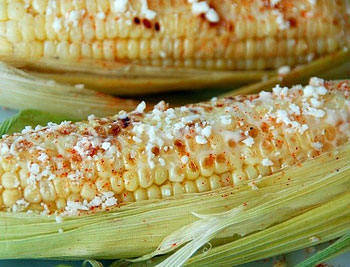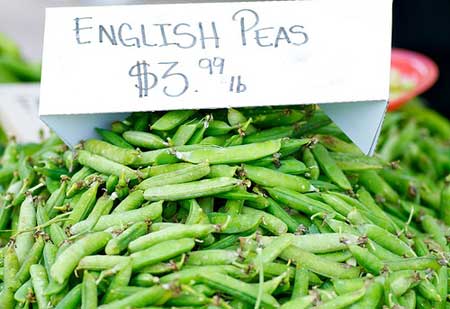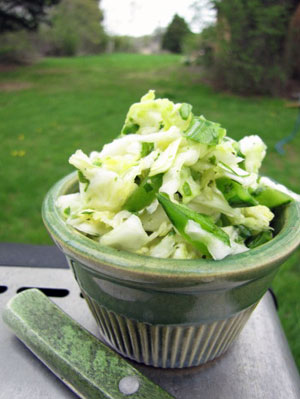 Three years ago I discovered something at the farmers' market that changed my life: it's called elote (Mexican grilled corn).
Three years ago I discovered something at the farmers' market that changed my life: it's called elote (Mexican grilled corn).
Despite the fact that it was only 10:30 in the morning, the aroma of smoky grilled corn lured Jeff and me to a stand where open grills were covered with plump ears of roasting corn. As soon as each ear was cooked it was quickly jammed onto a stick then drowned in a lime-spiked mayonnaise sauce, rolled in crumbly cotija anejo cheese and sprinkled with lime juice and cayenne pepper. Each customer's eyes widened in anticipation when handed this unusual treat.
Since that day, I have learned that the Spanish word "elote" can refer to corn or to grilled corn and that it's a common street food in many parts of Mexico. Like the famed fish taco, grilled corn is classic street food: unpretentious yet remarkable in its unique flavor. It's hot and creamy and salty and spicy, and utterly, wholeheartedly addictive.

 The other day at Sprouts, a local grocery store, a woman saw me selecting baby eggplant.
The other day at Sprouts, a local grocery store, a woman saw me selecting baby eggplant. When people ask why my husband and I live in San Diego instead of moving back to Rhode Island, I usually say, “the farmers’ markets.” I’m joking. Sort of. Really, how many other places
When people ask why my husband and I live in San Diego instead of moving back to Rhode Island, I usually say, “the farmers’ markets.” I’m joking. Sort of. Really, how many other places  This tasty burger recipe is nothing short of perfection. Gourmet Omaha Steaks Burgers are loaded with caramelized Jim Beam Black® Bourbon Onions that are so good your mouth will water before each savory bite. Top them off with melty brie cheese and a little mayo, then serve with a cup of warmed beef au jus for a blissful recipe that's sure to be a memorable hit at your next get-together!
This tasty burger recipe is nothing short of perfection. Gourmet Omaha Steaks Burgers are loaded with caramelized Jim Beam Black® Bourbon Onions that are so good your mouth will water before each savory bite. Top them off with melty brie cheese and a little mayo, then serve with a cup of warmed beef au jus for a blissful recipe that's sure to be a memorable hit at your next get-together! Peas, alas, are not a spring vegetable, despite what legions of food writers would have you believe. It is wonderful to think of things like spring pea risotto and minted pea soup in May, but unless you are lucky enough to live in a really temperate climate, you’ll be waiting for fresh peas until late June with the rest of us.
Peas, alas, are not a spring vegetable, despite what legions of food writers would have you believe. It is wonderful to think of things like spring pea risotto and minted pea soup in May, but unless you are lucky enough to live in a really temperate climate, you’ll be waiting for fresh peas until late June with the rest of us.